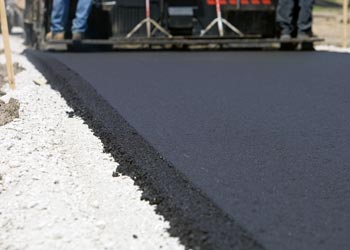Hot Mix Asphalt Paving: The Ultimate Service for Business Parking Lot Remodellings
Hot Mix Asphalt Paving: The Ultimate Service for Business Parking Lot Remodellings
Blog Article
Checking Out the Ecological Advantages of Warm Mix Asphalt
The usage of Warm Mix Asphalt in framework jobs offers an engaging situation for lasting advancement and environmental stewardship. By delving into the complex details of its manufacturing processes and the innovative use recycled materials, a much deeper understanding emerges of how this technology exceeds mere surface applications. The environmental advantages of Warm Mix Asphalt extend much beyond first impressions, providing a nuanced viewpoint on exactly how this product can lead the way for a greener future.

Lowered Greenhouse Gas Emissions
Warm Mix Asphalt manufacturing uses a substantial reduction in greenhouse gas discharges contrasted to other sidewalk products. The manufacturing process of Hot Mix Asphalt involves heating up the blend of accumulation and asphalt binder to heats. This process calls for less energy contrasted to the manufacturing of alternate sidewalk materials, leading to reduced greenhouse gas exhausts. In addition, the use of recycled materials in Hot Mix Asphalt further contributes to minimizing its ecological impact. By incorporating recovered asphalt pavement and recycled asphalt roof shingles into the mix, the demand for virgin materials is reduced, bring about power cost savings and lowered exhausts linked with removal and handling.
Studies have revealed that Warm Mix Asphalt pavements have a smaller sized carbon impact over their life process compared to various other pavement options. The sturdiness and recyclability of Hot Mix Asphalt additionally improve its environmental benefits by reducing the demand for regular upkeep or substitute, thus preserving sources and lessening exhausts connected with reconstruction activities.
Power Performance and Preservation
The manufacturing process of Hot Mix Asphalt not just decreases greenhouse gas discharges however additionally contributes significantly to energy effectiveness and preservation efforts. Power performance is a vital advantage of Hot Mix Asphalt manufacturing compared to various other sidewalk types. The procedure includes heating up the materials at high temperature levels to produce the asphalt mix, which needs much less power than alternative methods. In addition, the capacity to reuse and reuse asphalt pavement further enhances power preservation. By integrating reclaimed asphalt pavement (RAP) right into brand-new blends, the market saves energy that would have been required to produce completely new materials. The resilience of Hot Mix Asphalt decreases the frequency of upkeep and reconstruction, leading to lasting energy savings. This durability minimizes the energy-intensive procedures entailed in constant repairs and replacements. On The Whole, Warm Mix Asphalt sticks out as an environmentally friendly choice that prioritizes energy efficiency and conservation throughout its lifecycle.
Lasting Sidewalk Solutions

One secret element of lasting pavement solutions is making use of recycled materials such as reclaimed asphalt sidewalk (RAP) and recycled asphalt tiles (RAS) By including these products into the asphalt mixes, the need for virgin sources is lowered, leading to lower power consumption and greenhouse gas discharges throughout production. Additionally, the reuse of these materials aids divert waste from land fills, adding to a much more round and lasting economic situation.
Additionally, sustainable pavement remedies focus on optimizing pavement style to boost performance and durability. Techniques such as cozy mix asphalt (WMA) and rock mastic asphalt (SMA) improve the resilience and strength of sidewalks, reducing the requirement for regular repairs and replacements. By implementing these cutting-edge approaches, infrastructure designers can produce sidewalks that not only satisfy high-performance criteria however additionally reduce their environmental impact.
Minimized Environmental Influence
Warm mix asphalt, in particular, provides several advantages that contribute to minimizing the overall environmental impact of road infrastructure. One essential aspect is the recyclability of asphalt, which can be reused numerous times without endangering its top quality - Regrading.
Additionally, the manufacturing of hot mix asphalt produces lower levels of greenhouse gases contrasted to other sidewalk materials, making it a much more eco-friendly option. The energy efficiency of asphalt plants has actually also enhanced over the years, bring about minimized fuel intake and reduced emissions. Additionally, the smooth surface area of hot mix asphalt reduces rolling resistance for cars, causing reduced fuel intake and decreased air pollution from lorry emissions.
Contribution to Environment Modification Mitigation
Warm mix asphalt plays a vital duty in mitigating climate modification through its lasting buildings and minimized ecological impact. One considerable contribution to climate adjustment reduction comes from the energy efficiency of hot mix asphalt manufacturing. Compared to various other pavement alternatives, the production process for warm mix asphalt eats much less power and gives off lower degrees of greenhouse gases, therefore decreasing its general carbon impact.
In addition, warm mix asphalt's capacity to reflect sunshine, called albedo, helps in minimizing urban warmth island impacts. By minimizing heat absorption and retention, hot mix asphalt sidewalks can decrease the need for cooling in city locations, subsequently decreasing greenhouse gas discharges related to energy consumption for cooling down functions.
Additionally, the durability and recyclability of warm mix asphalt further enhance its environment adjustment mitigation capabilities. Regrading. The lengthy life-span of asphalt pavements lowers the demand for regular repair services or replacements, eventually lowering the carbon emissions connected to roadway maintenance activities. The recyclability of asphalt materials reduces the need for virgin sources and reduces the index environmental impact of sidewalk building and construction, straightening with lasting methods for climate adjustment reduction.
Verdict
In conclusion, the environmental advantages of Hot Mix Asphalt demonstrate its considerable payment to minimizing greenhouse gas discharges, saving energy, and lessening environmental impact. This lasting sidewalk remedy lines up with climate modification reduction efforts, advertises resource conservation, and improves framework development. By using recycled materials, energy-efficient manufacturing processes, and long lasting design, Warm Mix Asphalt plays a critical function in cultivating a much more ecologically pleasant approach to infrastructure building and construction.
The manufacturing procedure of Warm Mix Asphalt entails warming the find blend of accumulation and asphalt binder to high temperatures. By integrating redeemed asphalt pavement and recycled asphalt roof shingles into the mix, the need for virgin materials is minimized, leading to energy financial savings and decreased discharges connected with extraction and processing.
One trick aspect of lasting pavement options is the use of recycled materials such as reclaimed asphalt pavement (RAP) and recycled asphalt tiles (RAS) Strategies such as warm mix asphalt (WMA) and rock mastic asphalt (SMA) boost the resilience and resilience of sidewalks, lowering the requirement for regular fixings and substitutes. Compared to other pavement choices, the manufacturing procedure for warm mix read here asphalt eats less power and releases lower levels of greenhouse gases, hence minimizing its total carbon footprint.
Report this page